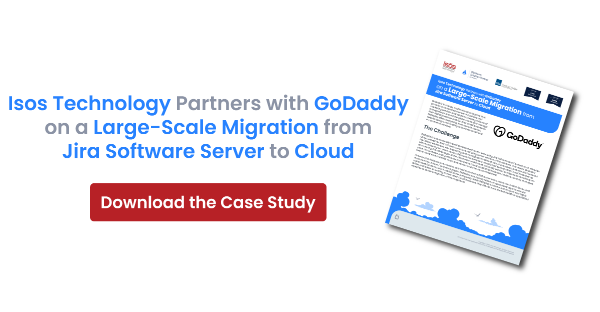 Migrating to Atlassian Cloud is challenging at best, particularly if your instance is large, if you have multiple instances, or if you need to bring over large amounts of data. While you can go it alone, most companies benefit from working with a trusted Atlassian migration partner like Isos Technology, that brings years of expertise and experience to the table. Isos can serve as a trusted advisor, helping you configure your Atlassian tools to align with your long-term strategic business objectives. They can also streamline the migration process significantly, often using proprietary tools to speed up the process and ensure no data is lost.
Migrating to Atlassian Cloud is challenging at best, particularly if your instance is large, if you have multiple instances, or if you need to bring over large amounts of data. While you can go it alone, most companies benefit from working with a trusted Atlassian migration partner like Isos Technology, that brings years of expertise and experience to the table. Isos can serve as a trusted advisor, helping you configure your Atlassian tools to align with your long-term strategic business objectives. They can also streamline the migration process significantly, often using proprietary tools to speed up the process and ensure no data is lost.
Following are four ways Isos Technology’s Atlassian Cloud migration services can streamline the migration process and make sure the end result meets your company’s long-term needs.
Strategic Guidance and Architecture Development
Atlassian tools often develop organically, with individual divisions, departments, and teams developing different processes over time. Based on best practices informed by years of experience with organizations of all types and sizes, as well as your own organization’s unique ways of working Isos Technology can provide strategic guidance and architecture and make sure your new Atlassian Cloud instance is optimized for your processes and aligned to your long-term strategic goals. That way, you can have confidence the new instance will serve your company well in the present and scale to meet your future needs.
System Cleanup
Organizations that have been using Atlassian tools for any length of time will likely have accumulated clutter—unnecessary, unused, duplicate, or obsolete users, projects, workflows, data, apps, etc. Clutter bogs down the system and adds to the complexity and risk of a migration. An Atlassian partner can help guide the client through cleanup efforts, archiving or deleting any clutter or data not needed in the new system. This will simplify the migration, minimize risk, and ensure optimal instance performance in Cloud.
Active and Historical Data Migration
Actual data migration is the most difficult and high-risk part of any migration, as there are any number of things that can go wrong and result in data loss or costly delays. During this phase of the process, Isos will configure your Cloud instance, map your existing data from the source environment to the destination environment, structure it in Atlassian-ready formats, and physically migrate it, using both Atlassian and proprietary tools. We'll bring over both active data and historical data required for compliance or other reasons.
Third-party app data migration can also add a lot of risk and complexity to a Cloud migration. Isos can assist with custom scripting and automation to ensure as much app data is migrated as possible while recommending similar Cloud apps for ones that don’t have Cloud versions. This process is highly iterative, and companies can expect trial runs before the final production cutover. Before the cutover to production, you can expect several rounds of validation and user acceptance testing to ensure that all necessary data has been brought over correctly.
User Training
Atlassian Cloud functionality differs from Server and Data Center versions—it incorporates native functionality that companies may have previously relied on third-party apps for, the apps themselves may have changed, and changes may even have been made to the core tools. For instance, the addition of Atlassian Access (an enterprise-grade identity and access tool for Cloud products) may mean users access the tools and authenticate differently. Isos can put processes in place and provide any necessary training to ensure both administrators and users are prepared to work in the new system.
To learn more about migrating to Atlassian Cloud, contact us today!
Sign up to receive more great content
Learn more about Atlassian and how Isos can help by signing up to receive our latest blogs, eBooks, whitepapers and more.














